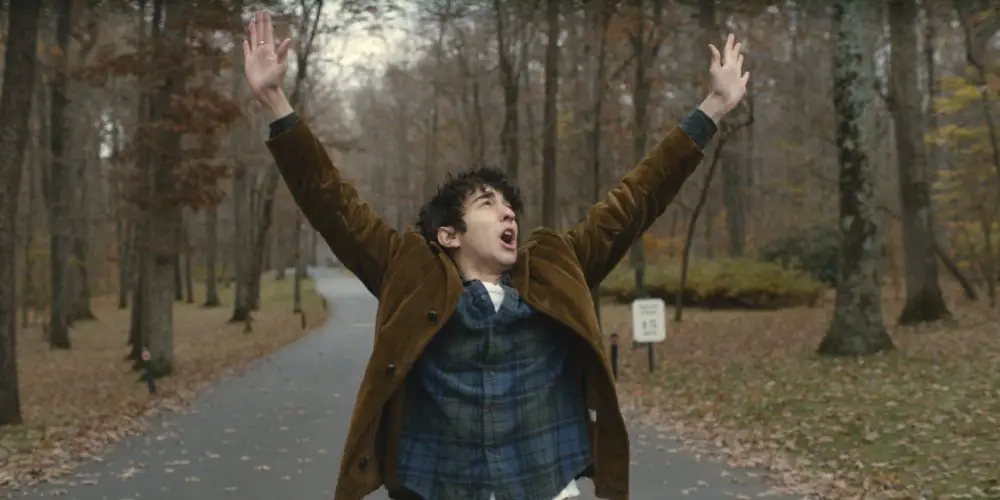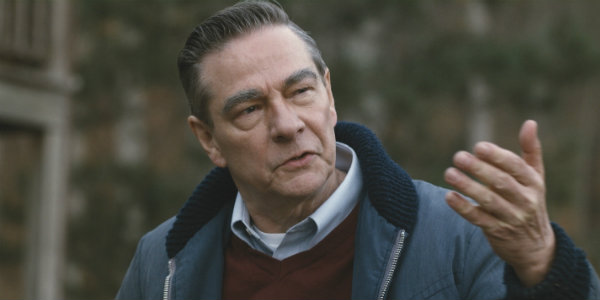COMING THROUGH THE RYE: A Troubling Piece Of Fan Fiction

English Major, Film Buff, and Citizen of the World, Sean…
Based on the real life personal experiences of writer and director James Steven Sadwith, Coming Through the Rye offers a strange and circuitous coming of age teen drama about a young boy named Jamie Schwartz who seeks out the reclusive author of “The Catcher in the Rye”, J.D. Salinger, in 1969 New Hampshire. Possessed of a thoroughly adolescent inspiration and buoyed by Salinger’s woefully misunderstood fictional protagonist Holden Caulfield, Jamie becomes dedicated to the idea of playing Salinger’s downtrodden hero on the stage.
Played with certain aplomb by former Nickelodeon child actor Alex Wolff, Jamie’s persistence in taking a road trip with fellow social misfit Deedee – played in the film by Stefania Owen – borders between the opposing emotional territories of sympathetic and irritating. Upon finding the reclusive Salinger, actor Chris Cooper plays the celebrated writer with a deserved sense of personal indignation and professional aloofness. Historically, Salinger was notorious over the course of his lifetime for his efforts to bar any theatrical adaptation of his magnum opus from being produced, ergo Cooper‘s dour demeanor.
Coming Through the Rye, even as it circumvents explicit adaptation of the novel which it unapologetically recalls, feels wrongheaded and disrespectful of the late Salinger’s wishes. Sadwith holds the torch of the Salinger super fan high above his head, but in its light, his shadow is cast as an usurper to the writer’s greatest work and idiosyncratic legacy.
Ennui In Abundance
In the few scenes wherein Salinger makes an appearence in Coming Through the Rye, Cooper manages to bring a fleeting tone of mature recrimination towards Wolff‘s hapless innocence. Cooper strikes a fine figure as the reclusive novelist, but his very presence betrays the very same taboo that serves as the film’s central narrative dilemma. He presents the case for Salinger’s real life reluctance to engage any offers from Hollywood to make his greatest work into a blockbuster theatrical event with measured cool. Meanwhile, Wolff – ostensibly serving as a rhetorical stand-in for Sadwith in the both the past and future tense – engages with the same dilemma sans any sort of engaged empathy or comprehensive understanding.

Sadwith undoubtedly loves J.D. Salinger and “The Catcher in the Rye”. Like many of us who grew up as angst-ridden teenagers angry at a world that never quiet seemed to understand us, Salinger gave welcome voice to our anguish. In Holden Caulfield many teens throughout the years have found a fellow social pariah willing to question the status quo and ultimately choose to live outside the expectations of mainstream society. In Wolff‘s portrayal of Jamie Schwartz – whose own biography reads like a CliffsNotes recap of the major plot points from Salinger’s Great American Novel – that story is reflected on the big screen almost exactly.
It would be foolhardy to accuse Coming Through the Rye of being anything greater than a coming-of-age teen dramedy. And for the most part Sadwith‘s offenses to Salinger’s legacy are minimal to irrelevant. But in surreptitiously recasting the seminal American novel in the light of his own adolescent ennui, Coming Through the Rye glaringly encroaches upon territory that Salinger himself may very well have frowned upon.
Sadwith may have had his own personal encounters with Salinger to call from in the making of what is a highly emotional recounting of the acclaimed author on the big screen. But in going forward with a movie that is so undisguisedly indebted to the very same book that the late writer forbid anyone from interpreting in any audio-visual medium, Coming Through the Rye perhaps goes father than even Salinger himself may have feared.
Adapting J.D. Salinger
Beyond adapting “The Catcher in the Rye” into a major motion picture, the greatest fault that Coming Through the Rye commits is in adapting J.D. Salinger the author. As a character in Sadwith‘s film, Salinger becomes synonymous with the basic temperament and poetic aspirations of his greatest fictional creation, Holden Caulfield. Instead of casting Jamie Schwartz as a poor man’s Holden, Sadwith goes just a step further and has Cooper play the man behind the legend.

In 2013, documentary filmmaker Shane Salerno released the film Salinger in tandem to the publication of a 700-page biography of the same name co-written by The New York Times writer David Shields. The documentary received immediate acclaim from critics prior to its world premiere, and was picked up by Harvey Weinstein and PBS for domestic release in theaters and on broadcast television. Salerno‘s effort went on to become one of the top ten highest grossing documentaries of the year, in addition to attracting two million American Masters viewers on PBS.
And yet Salinger failed to receive the kind of mainstream critical reception that it at first seemed destined to attract. Mixing exhaustive research with a few ill-applied dramatizations throughout, Salerno had miraculously unearthed too much about his enigmatic and reclusive folk hero. In the same manner, Sadwith has once again shed light on Salinger as a character perhaps a little too brightly.
Part of what makes The Catcher in the Rye so compelling in retrospect to begin with is how little is known about the man who wrote it. Scarred by his experiences in the limelight of fame and celebrity, the rising writer of American letters fled to secrecy and hermitage. The fact that so many sought his very essence as some kind of symbol of status and prestige irked the World War II veteran to no end.

For some, the degree to which Salinger walled himself off from an apparently adoring public can be seen as behaving in a standoffish and anti-social manner. Likewise, Salinger’s refusal to sell the rights to “The Catcher in the Rye” to many interested Hollywood parties over the years can be interpreted as an aggressive rebuke of popular affection. Sadwith might disagree. Yet Coming Through the Rye displays such a willful disregard of Salinger’s pleas for privacy and the sanctity of his written work as solitary exercises of the mind that it becomes difficult to see his film as anything more than a troubling piece of fan fiction.
Conclusion
Coming Through the Rye does a remarkable job of subverting the basic premise, thematic concerns, and cultural legacy of “The Catcher in the Rye” to novel ends. As Jamie Schwartz, Alex Wolff captures much of the youthful immaturity and spirited determination of Holden Caulfield. Likewise, Sadwith manages to capture a lot of what makes J.D. Salinger a persistent barometer of adolescent angst and alienation in his directorial debut. It’s just too bad that in casting Gary Cooper as the infamous author of a collective coming-of-age fantasy, Sadwith didn’t catch wind of some of the hubris inherent to said feat.
Worse than casting Wolff as Holden Caulfield in a theatrical adaptation of “The Catcher in the Rye”, Sadwith misguidedly summons the essence of Salinger as a benign gatekeeper of a thoroughly American cultural heritage. It’s hard to come away from watching Coming Through the Rye without remembering how wounded and world weary Cooper wears the role of Salinger as a performance that may well have been better left alone as words on a page.
Do you remember reading “The Catcher in the Rye” when you were young? Would you consider yourself a fan of J.D. Salinger?
Coming Through the Rye is currently playing in select theaters in the U.S. Find international release dates here.
Does content like this matter to you?
Become a Member and support film journalism. Unlock access to all of Film Inquiry`s great articles. Join a community of like-minded readers who are passionate about cinema - get access to our private members Network, give back to independent filmmakers, and more.
English Major, Film Buff, and Citizen of the World, Sean K. Cureton is a born and raised Jersey Boy. Having received a B.A. in English from Rutgers University, Sean is proud to call the Garden State his home, equidistant from both the steps that made Sylvester Stallone a household name, and the park where Harry was cordially introduced to Sally, even if he’d prefer to a stay in state due to a certain fondness for a convenience store located in Leonardo, NJ. When he’s not in the multiplex, you can follow him on Twitter, @seankcureton.












